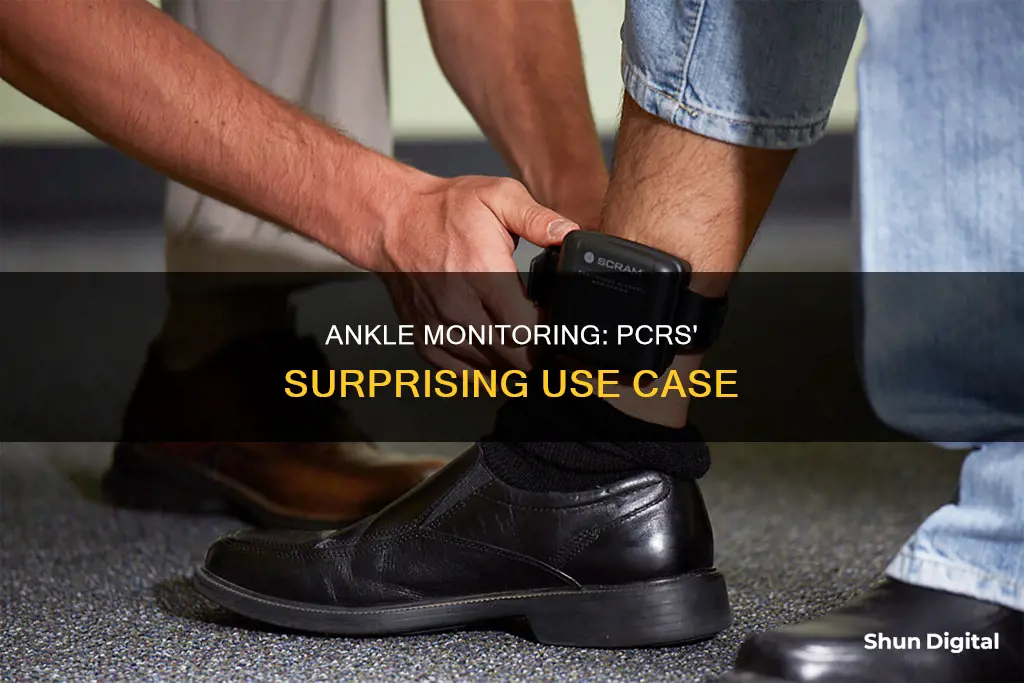
Ankle monitoring is a form of surveillance that uses an electronic device, typically fitted above the ankle, to track the movements and activities of individuals. This method of monitoring has become increasingly popular in recent years, with the number of people wearing ankle monitors more than doubling from 2005 to 2015. Ankle monitors are used for defendants awaiting trial and convicted offenders on parole or probation, with some people being required to wear them for the rest of their lives. The devices use GPS and RF technology to monitor an individual's location and can be set up to alert authorities if the wearer enters a predetermined excluded area. While ankle monitoring is seen as a creative way to allow people to live in their homes rather than being incarcerated, there are concerns about their accuracy, comfort, and impact on the wearer's mental health and daily life.
What You'll Learn

Ankle monitoring as an alternative to incarceration
Ankle monitoring has been increasingly viewed as a more humane alternative to incarceration. However, a report by Kate Weisburd, an associate professor of law at George Washington University, and a team of law students, sheds light on how electronic monitoring can cause similar harms to traditional incarceration. The report found that electronic monitoring deprives people of their fundamental rights, violates privacy, extracts wealth, jeopardizes employment, and undermines family and social relationships.
A Prisoner in Their Own Home
People with ankle monitors are often required to remain in their homes unless they obtain pre-approval, which must be sought in advance and is not always granted, even for routine activities. This restriction can lead to social isolation and a sense of being a "prisoner in their own home."
Invasion of Privacy
Ankle monitors capture, analyze, and store location and movement data, often sharing this information with law enforcement agencies and the courts. Most policies do not provide privacy protections, and the privacy of family and friends is also impacted through invasive home searches.
Wealth Extraction
Most jurisdictions require individuals to pay expensive user fees for ankle monitors, which can range from $3 to $35 per day, in addition to setup charges. These costs can amount to hundreds of dollars per month, creating a financial burden for individuals and their families.
Employment and Social Relationships
The restrictions imposed by ankle monitors can make it difficult to maintain employment and social connections. Individuals may be limited in their ability to travel or engage in certain activities, impacting their ability to work, attend school, or spend time with family and friends.
Recidivism and Rehabilitation
While ankle monitoring is intended to reduce recidivism, studies show that it may not effectively meet this goal. Instead, it can lead to "e-carceration", where individuals are sent back to jail or prison for minor technical violations, charging malfunctions, or false alarms.
In conclusion, while ankle monitoring can provide an alternative to incarceration, it is important to consider the potential negative impacts on individuals' rights, privacy, financial situation, employment, and social connections. It is crucial to implement measures that ensure due process, fairness, and reduce potential harms associated with ankle monitoring.
Eliminating Gridlines: A Guide for ASUS Monitor Users
You may want to see also

Who uses ankle monitoring and why
Ankle monitoring is used by people awaiting trial, serving probation and parole, and facing immigration proceedings. It is also used in healthcare settings and for those released on bail.
In the US, every state and the federal government use ankle monitoring to track the movements and activities of defendants awaiting trial and convicted offenders currently on parole or probation. In the UK, it is used for those on bail, and for released prisoners under home detention.
Ankle monitors are also used as an alternative to prison sentences for people with substance abuse issues. A Secure Continuous Remote Alcohol Monitor (SCRAM) bracelet can detect alcohol in a person's sweat, alerting authorities if the wearer violates the terms of their release.
In the healthcare sector, ankle monitors are used to track elderly people in care homes and those with dementia, although this is controversial due to concerns over patient safety and human rights.
Setting Up Remote Vivint Access Without Monitoring
You may want to see also

How ankle monitors work
Ankle monitors are used as an alternative to traditional incarceration, with the aim of reducing prison overcrowding. They are also used as a way to allow people to live in their own homes who may otherwise be in jail.
Ankle monitors work by notifying monitoring agencies about a wearer's whereabouts and/or alcohol consumption. They are locked into place around the wearer's ankle and use GPS technology or radio frequency to transmit location data to a monitoring centre. The data is sent to an on-site transmitter, usually located in the wearer's home, and then to a remote receiver, which may be at a police station or monitoring centre. If the data indicates a breach, such as leaving a designated area, the proper authorities are alerted.
There are three main types of ankle monitors: Radio Frequency (RF), Global Positioning System (GPS), and Secure Continuous Remote Alcohol Monitoring (SCRAM). RF monitors inform the monitoring party about the general whereabouts of the device in relation to the home-based unit, while GPS monitors divulge specific geographical coordinates. SCRAM systems monitor location and detect alcohol consumption by testing the wearer's sweat.
Ankle monitors are designed to be tamper-resistant and will alert authorities if an attempt is made to remove the device. They are usually waterproof and fairly lightweight, but they are not permitted through airport security. The battery needs to be charged regularly, and the device must stay in constant contact with the authorities.
Blind Spot Monitoring: Standard or Optional on Camaro 2SS?
You may want to see also

The cost of ankle monitoring
Ankle monitoring is promoted as a humane alternative to jail, but it comes at a high cost for those who are monitored. Private companies charge defendants hundreds of dollars a month to wear the devices, and if they can't pay, they may end up back in jail. This cost is in addition to initial setup charges, which can range from $100 to $200, plus a $50 installation fee. The daily fees to wear an ankle monitor can range from $3 to $35 per day, or $5 to $25 per day, according to different sources. In some states, missing a payment could result in the person being sent back to jail.
For those who are already struggling financially, these costs can be overwhelming and can lead to further debt and difficulties. In the case of Daehaun White, a 19-year-old from St. Louis, he was required to pay $10 per day for his ankle monitor, in addition to a $300 upfront payment and a $50 installation fee. White struggled to find the money to pay for the monitor, as he was earning minimum wage and his family was also facing financial difficulties.
The high cost of ankle monitoring can also lead to people pleading guilty in order to avoid the ongoing fees. In the case of Daehaun White, he considered pleading guilty to get out of paying the daily fees. Additionally, people who are monitored may lose their jobs due to the restrictions and stigma associated with wearing an ankle monitor, further impacting their financial situation.
The financial burden of ankle monitoring falls disproportionately on marginalized communities, exacerbating existing inequalities. In Detroit, for example, Black people are twice as likely as white people to be electronically monitored. The high cost of ankle monitoring can create a cycle of debt and incarceration, particularly for those who are already economically disadvantaged.
While ankle monitoring may be presented as a cost-effective alternative to incarceration, the financial burden is often shifted onto those who are monitored, creating significant financial challenges and contributing to the cycle of debt and incarceration.
Simple Ways to Identify a 1440p Monitor Resolution
You may want to see also

The effectiveness of ankle monitoring
Ankle monitoring, or electronic monitoring (EM), is a tool used in community corrections to promote accountability and compliance. It is often used as an alternative to incarceration, allowing people to live in their homes and maintain employment and family connections. EM is highly regarded within the industry, with studies showing that it is cost-effective, helps reduce prison populations, and reduces an individual's chances of returning to jail.
EM typically uses GPS tracking systems to record the location of the wearer and ensure they are abiding by the terms of their sentence. This can include people awaiting trial, serving probation and parole, or facing immigration proceedings. For example, a Secure Continuous Remote Alcohol Monitor (SCRAM) bracelet can detect alcohol in a person's sweat, alerting authorities if they violate the terms of their release.
One of the benefits of EM is its cost-effectiveness. A 2012 study by the District of Columbia Crime Policy Institute found that, on average, EM reduces arrests by 24% for program participants, reduces per-participant costs to local agencies, and generates societal benefits through reduced recidivism. Additionally, EM can help reduce prison populations by providing an alternative to incarceration. This is especially relevant in the context of the COVID-19 pandemic, where prisons and jails became hotspots for outbreaks, and jurisdictions sought alternatives to reduce the spread of the disease.
However, there are also concerns about the effectiveness and potential negative impacts of EM. Studies have shown that EM fails to meet its stated goals of ensuring court appearances, protecting public safety, and advancing rehabilitation. Instead, it can lead to digital incarceration, with people being sent to physical jails and prisons for minor technical violations, charging malfunctions, and false alarms. Additionally, EM can exacerbate systemic inequities along lines of race, class, and disability. For example, in Detroit, Black people are twice as likely as white people to be electronically monitored. The fees associated with EM, which can range from $3 to $35 per day, can also be burdensome for individuals and families, further compounding existing inequalities.
Furthermore, EM can have negative psychological impacts on wearers, leading to stigma, social isolation, and increased stress, anxiety, and depression. The restrictions on movement and activities can also be challenging, impacting individuals' ability to work, attend school, and access basic necessities. In some cases, the discomfort and inconvenience of EM may lead people to cut off their monitors out of frustration.
While EM has been shown to produce positive effects for certain offenders, such as sex offenders, and at certain points in the criminal justice process, it is important to carefully consider its potential drawbacks and implement it in a way that minimizes negative consequences.
Asus Speakers: On, Monitor Off — Tricks and Tips
You may want to see also
Frequently asked questions
Ankle monitors are devices that track the movements of individuals who have been sentenced to restricted travel or activities. They are typically worn around the lower leg and use GPS and RF technology to monitor the wearer's location and ensure they abide by the terms of their sentence.
Ankle monitors are used to track the movements and activities of defendants awaiting trial, convicted offenders on parole or probation, and people facing immigration proceedings. They are also used in healthcare settings, particularly for patients with dementia to prevent them from wandering away.
The effectiveness of ankle monitors is debated. While they have been shown to deter people from reoffending and ensure compliance with court orders, they have also been criticised for failing to meet their stated goals of ensuring court appearances, protecting public safety, and advancing rehabilitation. Additionally, ankle monitors have been associated with issues such as stigma, social isolation, and increased financial burden for wearers and their families.







